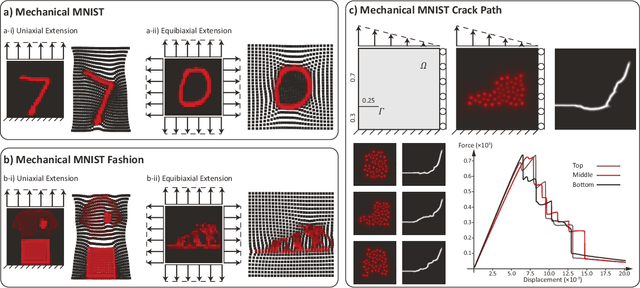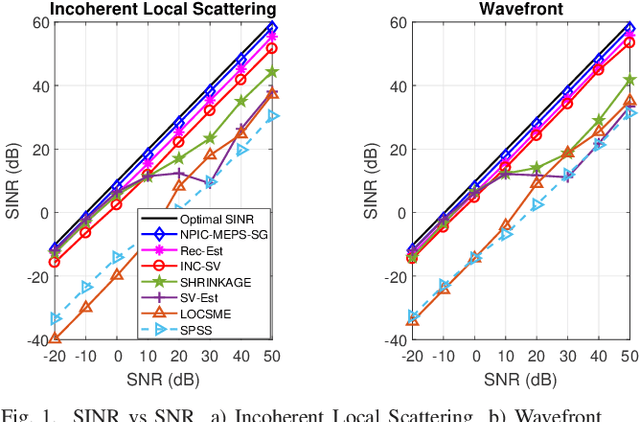S. Mohammadzadeh
Study of Robust Adaptive Beamforming Algorithms Based on Power Method Processing and Spatial Spectrum Matching
Sep 25, 2023Abstract:Robust adaptive beamforming (RAB) based on interference-plus-noise covariance (INC) matrix reconstruction can experience performance degradation when model mismatch errors exist, particularly when the input signal-to-noise ratio (SNR) is large. In this work, we devise an efficient RAB technique for dealing with covariance matrix reconstruction issues. The proposed method involves INC matrix reconstruction using an idea in which the power and the steering vector of the interferences are estimated based on the power method. Furthermore, spatial match processing is computed to reconstruct the desired signal-plus-noise covariance matrix. Then, the noise components are excluded to retain the desired signal (DS) covariance matrix. A key feature of the proposed technique is to avoid eigenvalue decomposition of the INC matrix to obtain the dominant power of the interference-plus-noise region. Moreover, the INC reconstruction is carried out according to the definition of the theoretical INC matrix. Simulation results are shown and discussed to verify the effectiveness of the proposed method against existing approaches.
Efficient Covariance Matrix Reconstruction with Iterative Spatial Spectrum Sampling
Sep 02, 2023Abstract:This work presents a cost-effective technique for designing robust adaptive beamforming algorithms based on efficient covariance matrix reconstruction with iterative spatial power spectrum (CMR-ISPS). The proposed CMR-ISPS approach reconstructs the interference-plus-noise covariance (INC) matrix based on a simplified maximum entropy power spectral density function that can be used to shape the directional response of the beamformer. Firstly, we estimate the directions of arrival (DoAs) of the interfering sources with the available snapshots. We then develop an algorithm to reconstruct the INC matrix using a weighted sum of outer products of steering vectors whose coefficients can be estimated in the vicinity of the DoAs of the interferences which lie in a small angular sector. We also devise a cost-effective adaptive algorithm based on conjugate gradient techniques to update the beamforming weights and a method to obtain estimates of the signal of interest (SOI) steering vector from the spatial power spectrum. The proposed CMR-ISPS beamformer can suppress interferers close to the direction of the SOI by producing notches in the directional response of the array with sufficient depths. Simulation results are provided to confirm the validity of the proposed method and make a comparison to existing approaches
Predicting Mechanically Driven Full-Field Quantities of Interest with Deep Learning-Based Metamodels
Jul 24, 2021



Abstract:Using simulation to predict the mechanical behavior of heterogeneous materials has applications ranging from topology optimization to multi-scale structural analysis. However, full-fidelity simulation techniques such as Finite Element Analysis can be prohibitively computationally expensive when they are used to explore the massive input parameter space of heterogeneous materials. Therefore, there has been significant recent interest in machine learning-based models that, once trained, can predict mechanical behavior at a fraction of the computational cost. Over the past several years, research in this area has been focused mainly on predicting single Quantities of Interest (QoIs). However, there has recently been an increased interest in a more challenging problem: predicting full-field QoI (e.g., displacement/strain fields, damage fields) for mechanical problems. Due to the added complexity of full-field information, network architectures that perform well on single QoI problems may perform poorly in the full-field QoI problem setting. The work presented in this paper is twofold. First, we made a significant extension to the Mechanical MNIST dataset designed to enable the investigation of full field QoI prediction. Specifically, we added Finite Element simulation results of quasi-static brittle fracture in a heterogeneous material captured with the phase-field method. Second, we established strong baseline performance for predicting full-field QoI with MultiRes-WNet architecture. In addition to presenting the results in this paper, we have released our model implementation and the Mechanical MNIST Crack Path dataset under open-source licenses. We anticipate that future researchers will directly use our model architecture on related datasets and potentially design models that exceed the baseline performance for predicting full-field QoI established in this paper.
Low-Cost Maximum Entropy Covariance Matrix Reconstruction Algorithm for Robust Adaptive Beamforming
Dec 28, 2020

Abstract:In this letter, we present a novel low-complexity adaptive beamforming technique using a stochastic gradient algorithm to avoid matrix inversions. The proposed method exploits algorithms based on the maximum entropy power spectrum (MEPS) to estimate the noise-plus-interference covariance matrix (MEPS-NPIC) so that the beamforming weights are updated adaptively, thus greatly reducing the computational complexity. MEPS is further used to reconstruct the desired signal covariance matrix and to improve the estimate of the desired signals's steering vector (SV). Simulations show the superiority of the proposed MEPS-NPIC approach over previously proposed beamformers.
 Add to Chrome
Add to Chrome Add to Firefox
Add to Firefox Add to Edge
Add to Edge